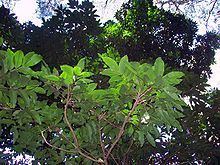Kingdom Plantae Family Rutaceae Scientific name Flindersia bennettiana | Order Sapindales Genus Flindersia Rank Species | |
 | ||
Similar Flindersia schottiana, Flindersia xanthoxyla, Flindersia, Flindersia collina, Flindersia australis | ||
Flindersia bennettii is an Australian rainforest tree in the citrus family. It is known as the Bennett's Ash, named after the naturalist, Dr. George Bennett.
Contents
It occurs mainly in streamside, seaside or subtropical rainforest. The natural range of distribution is from the Clarence River, New South Wales to Bundaberg in south eastern Queensland.
Description
A tree up to 40 metres in height, and a trunk diameter of 90 cm. The trunk is cylindrical and tall with moderately smooth grey bark. The bark features some small bumps and scales. Small branches show distinct leaf scars, and lenticels. New shoots are green and downy.
Leaves
3 to 10 opposite leaflets per compound leaf. Leaflets 6 to 19 cm long, 1.7 to 8 cm wide. Bright green above, duller below with a blunt leaf tip. Leaves dissimilar at the base, with one part of the leaflet broader and more curved than the other. Leaflet stalk 1 to 4 mm long, but the terminal leaflet has a longer stem, occasionally over 15 to 30 mm.
The compound leaf stem is 3 to 10 cm long, mostly flattened on the top part, with two sharp edges. Leaf mid rib, lateral and net veins seen above and below. 15 to 20 pairs of lateral veins are present.
Flowers & fruit
Cream flowers form on panicles from February to August. Flowers with a dough like scent. Panicles grow from the forks of leaves or at the end of branchlets. The fruit is a brown woody capsule, with blunt prickles. 4 to 8 cm long. Opening up in 5 valves. Each valve has a woody middle divide, and on each side are two or three seeds. The wind blown seeds mature from November to February.
Timber
Straight grained and easily worked. Previously used for timber in the construction of coaches, boat building, cabinet and joinery work. It is an excellent carving wood. The weight is between 800 and 850 kilograms per cubic metre.
